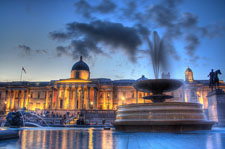National
Gallery
Founded in 1824, with just a small purchase of
38 paintings, the National Gallery in London, England, now
houses a magnificent collection of more than 2300 paintings that
date from the mid-13th century to the early 20th century, the
museum occupies space on Trafalgar Square. This fabulous museum
would be shaped by its early directors, most notably, Sir
Charles Lock Eastlake, and private donations that make up
two-thirds of the collection today. Although this is a small
collection compared to many of the larger and famous art
galleries in Europe, it is more encyclopedic in scope, with
outstanding developments in Western paintings from Giotto to
Cezanne. At one time, it could claim that its entire permanent
collection could be shown at one time, it is not so any longer.
This is the third home for the excellent museum, and was
designed by William Wilkins from 1832 to 1838, and only the
facade facing the square is still original; since it has been
enlarge by piecemeal over the years. The gallery has a marvelous
history and should be enjoyed when time avails, or when you
visit, and would be too much material to mention here. At the
turn of the 20th century, there appeared an agricultural crisis
that would force many affluent families to sell off their
glorious and beautiful paintings to survive, but their
collections would be priced out of the market by the American
plutocrats, so a National Art Collections Fund would be started.
Just after the start of WWII, the paintings would be moved from
their various locations to a more secure one, if it could be
found. One suggestion was made to send them to Canada, but
Winston Churchill would personally write a telegram to director
Kenneth Clark, suggesting that he could "bury them in caves or
cellars", but not one of those paintings would leave these
islands. After the war ended, acquisitions would become even
more difficult to acquire, at the prices that the old masters
were selling for, and worse for impressionists and
post-impressionists. Some of the most important and valuable
paintings would never have been acquired if not for the help of
huge public appeals, and these would include; The Virgin and
Child with St. Anne and St. John the Baptist that was painted by
Leonardo da Vinci that was purchased in 1962 and Titian's Death
of Actaeon in 1972. In 1985, the fund would be frozen by the
government, but then, later that year, Sir Paul Getty would give
them an endowment of 50 million pounds to that numerous major
purchases could be made; and quite ironically, the institution
that would be their biggest competitor for acquisitions would
the J. Paul Getty Museum in California. Although there are way
to many magnificent paintings to mention at one time, a few of
the most famous highlights include; Venus and Mars by Sandro
Botticelli, the Virgin of the Rocks by Leonardo da Vinci, the
Manchester Madonna by Michelangelo, Belshazzar's Feast by
Rembrandt, Les Grandes Baigneuses by Paul Cezanne, The
Water-Lily Pond by Claude Monet, the Umbrellas by Pierre-Auguste
Renoir, Sunflowers by Vincent van Gogh, and Portrait of Pope
Julius II by Raphael.
|

